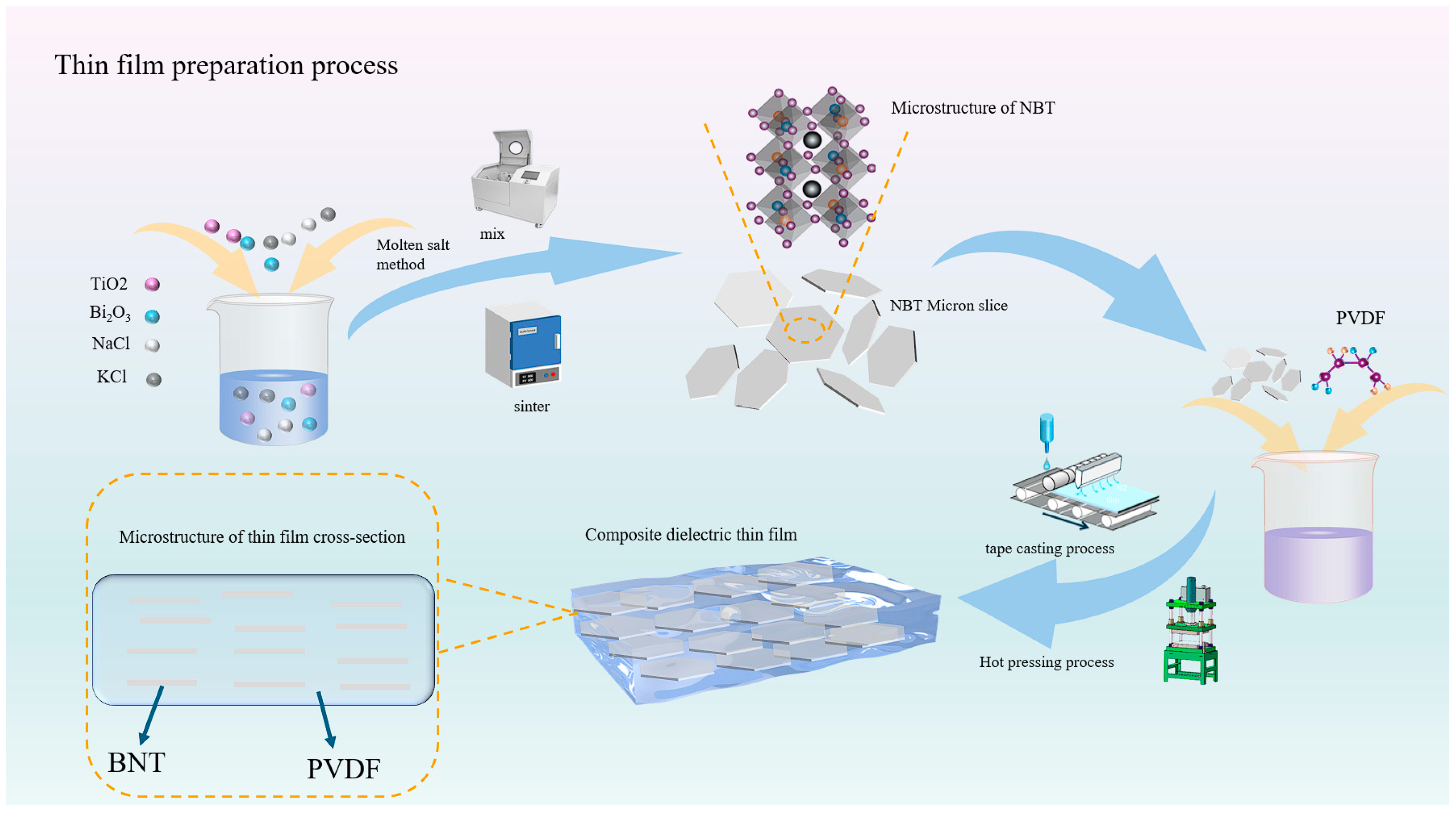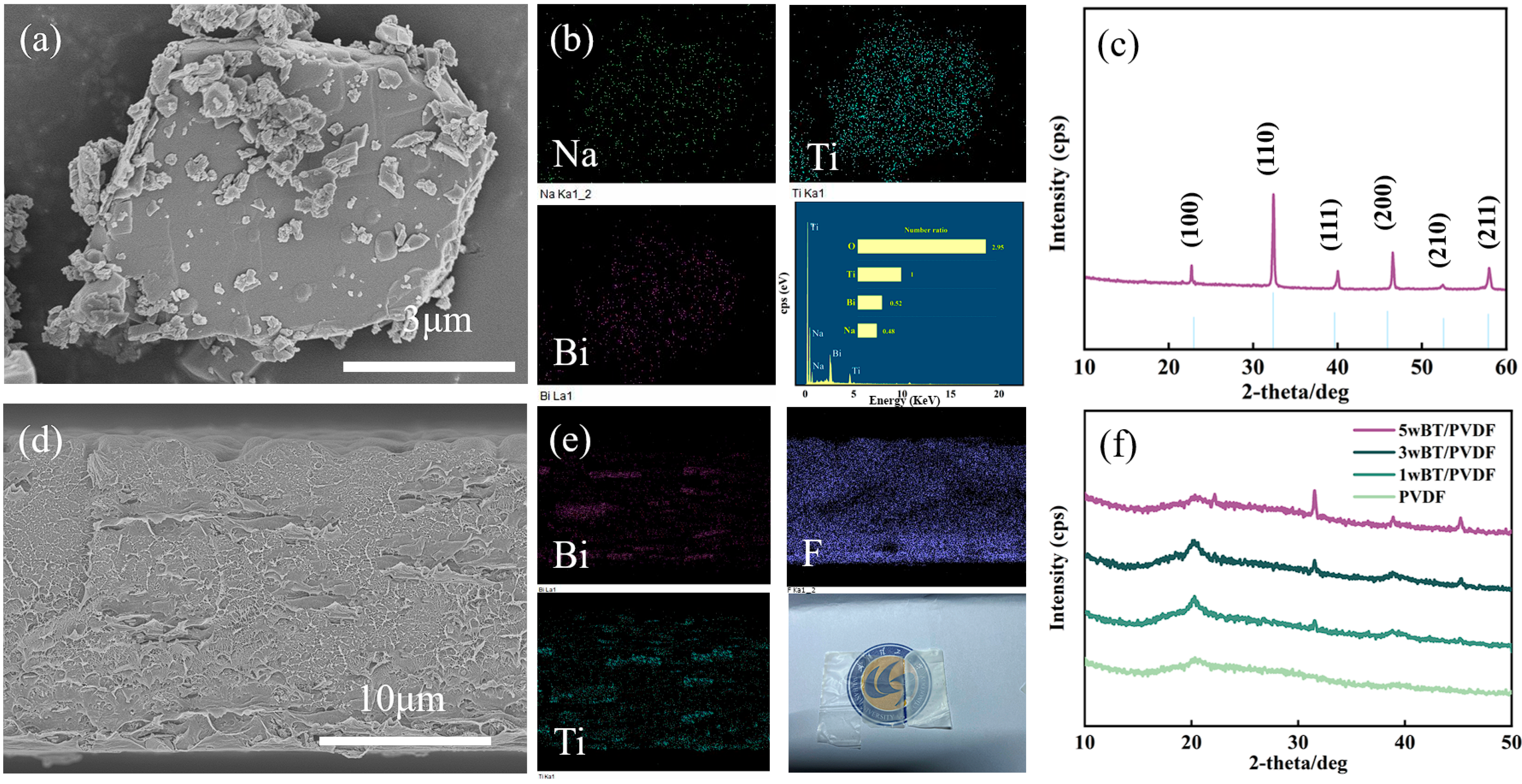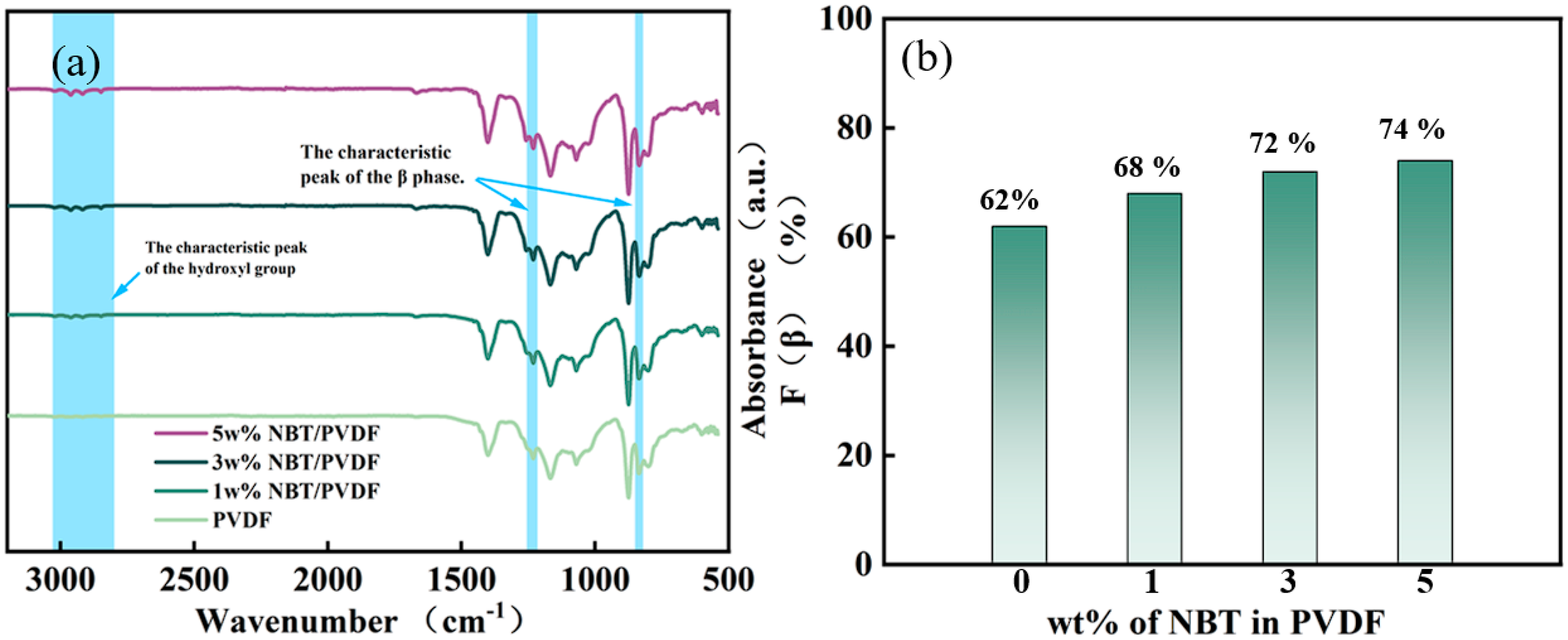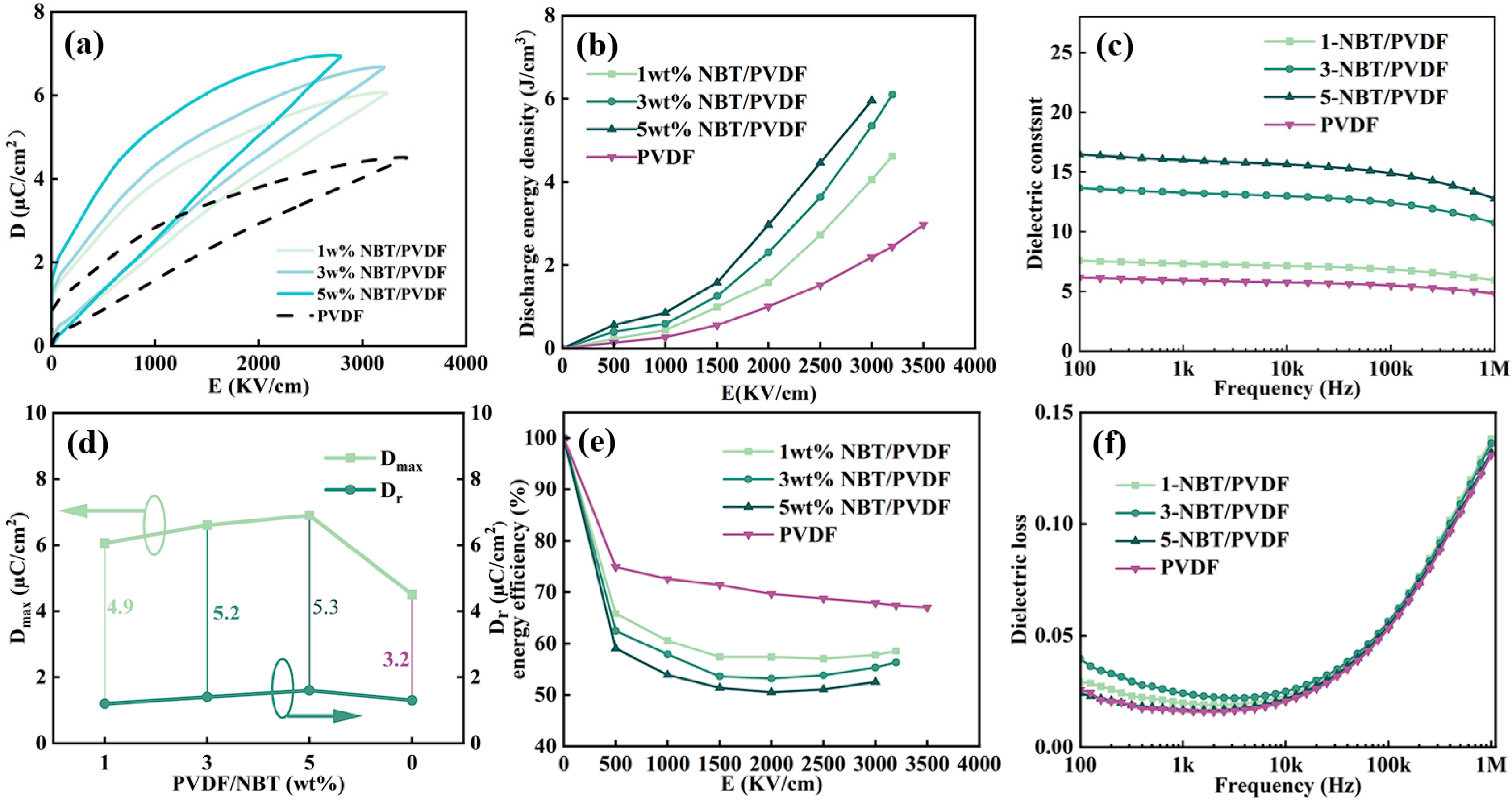Enhanced Energy Storage Capacity in NBT Micro-Flake Incorporated PVDF Composites
Abstract
1. Introduction
2. Experimental Section
2.1. Materials
2.2. Ceramic Filler Fabrication
2.3. Film Fabrication
2.4. Material Characterization
2.5. Energy Storage Performance
2.6. Calculation of β Phase
3. Results and Discussion
4. Conclusions
Author Contributions
Funding
Institutional Review Board Statement
Data Availability Statement
Conflicts of Interest
References
- Zhao, J.; Burke, A.F. Electrochemical Capacitors: Performance Metrics and Evaluation by Testing and Analysis. Adv. Energy Mater. 2021, 11, 2002192. [Google Scholar] [CrossRef]
- He, Q.; Sun, K.; Shi, Z.; Liu, Y.; Fan, R. Polymer Dielectrics for Capacitive Energy Storage: From Theories, Materials to Industrial Capacitors. Mater. Today 2023, 68, 298–333. [Google Scholar] [CrossRef]
- Yang, H.-J.; Lu, Z.; Li, L.; Bao, W.; Ji, H.; Li, J.; Feteira, A.; Xu, F.; Zhang, Y.; Sun, H.; et al. Novel BaTiO3-Based, Ag/Pd-Compatible Lead-Free Relaxors with Superior Energy Storage Performance. ACS Appl. Mater. Interfaces 2020, 12, 43942–43949. [Google Scholar] [CrossRef] [PubMed]
- Yazawa, K.; Ducharne, B.; Uchida, H.; Funakubo, H.; Blendell, J.E. Barkhausen Noise Analysis of Thin Film Ferroelectrics. Appl. Phys. Lett. 2020, 117, 012902. [Google Scholar] [CrossRef]
- Xu, B.; Ren, S. Integrated Charge Transfer in Organic Ferroelectrics for Flexible Multisensing Materials. Small 2016, 12, 4502–4507. [Google Scholar] [CrossRef]
- Lai, K. Spontaneous Polarization in van Der Waals Materials: Two-Dimensional Ferroelectrics and Device Applications. J. Appl. Phys. 2022, 132, 121102. [Google Scholar] [CrossRef]
- Lu, R.; Shen, Z.; Ma, C.; Duan, T.; Lu, L.; Hu, G.; Hu, T.-Y.; You, C.; Mi, S.; Jia, C.-L.; et al. Ultrahigh-Temperature Film Capacitors via Homo/Heterogeneous Interfaces. J. Mater. Chem. A 2022, 10, 17166–17173. [Google Scholar] [CrossRef]
- Wang, Y.; Yang, D.; Hessien, M.M.; Du, K.; Ibrahim, M.M.; Su, Y.; Mersal, G.A.M.; Ma, R.; El-Bahy, S.M.; Huang, M.; et al. Flexible Barium Titanate@polydopamine/Polyvinylidene Fluoride/Polymethyl Methacrylate Nanocomposite Films with High Performance Energy Storage. Adv. Compos. Hybrid Mater. 2022, 5, 2106–2115. [Google Scholar] [CrossRef]
- Mahajan, U.; Dhonde, M.; Das, M.; Sahu, K.; Sakthivel, P.; Shirage, P.M. Unlocking the Potential of Zirconia Nanostructures in Electrochemical Sensing and Sustainable Energy Solutions. Chem. Eng. J. 2025, 511, 162156. [Google Scholar] [CrossRef]
- Djoković, V.; Dudić, D.; Dojčilović, R.; Marinković, F.S.; Pavlović, V.P.; Pavlović, V.B.; Vlahovic, B. Toward Improved PVDF-BaTiO3 Composite Dielectrics: Mechanical Activation of the Filler versus Filler Content. Phys. Scr. 2023, 98, 115932. [Google Scholar] [CrossRef]
- Jing, L.; Li, W.; Gao, C.; Li, M.; He, J. Highly Enhanced Dielectric Performances in PVDF-Based Nanocomposites Filled with (Eu0.2Bi0.2Y0.2La0.2Cr0.2)2O3 High-Entropy Oxide Nanofibers. Polymer 2022, 262, 125428. [Google Scholar] [CrossRef]
- Hu, X.; Yi, K.; Liu, J.; Chu, B. High Energy Density Dielectrics Based on PVDF-Based Polymers. Energy Technol. 2018, 6, 849–864. [Google Scholar] [CrossRef]
- Feng, Q.-K.; Ping, J.-B.; Zhu, J.; Pei, J.-Y.; Huang, L.; Zhang, D.-L.; Zhao, Y.; Zhong, S.-L.; Dang, Z.-M. All-Organic Dielectrics with High Breakdown Strength and Energy Storage Density for High-Power Capacitors. Macromol. Rapid Commun. 2021, 42, e2100116. [Google Scholar] [CrossRef] [PubMed]
- Develos-Bagarinao, K.; Budiman, R.A.; Ishiyama, T.; Yamaji, K.; Kishimoto, H. Leveraging Catalytic Effects of Heterointerfaces through Multilayering for Superior Cathode Performance. J. Power Sources 2020, 480, 229094. [Google Scholar] [CrossRef]
- Lu, R.; Wang, J.; Duan, T.; Hu, T.-Y.; Hu, G.; Liu, Y.; Fu, W.; Han, Q.; Lu, Y.; Lu, L.; et al. Metadielectrics for High-Temperature Energy Storage Capacitors. Nat. Commun. 2024, 15, 6596. [Google Scholar] [CrossRef]
- Silva, J.P.; Silva, J.M.; Oliveira, M.J.S.; Weingärtner, T.; Sekhar, K.C.; Pereira, M.; Gomes, M.J.M. High-Performance Ferroelectric–Dielectric Multilayered Thin Films for Energy Storage Capacitors. Adv. Funct. Mater. 2018, 29, 1807196. [Google Scholar] [CrossRef]
- Liu, Y.; Hu, T.-Y.; Liu, M.; Lu, R.; Lu, L.; Lu, Y.; Han, Q.; Fu, W.; Duan, T.; Dai, Y.; et al. High-Energy Density Dielectric Film Capacitors Enabled by Grain Boundary Engineering. J. Mater. Chem. A 2025, 13, 4309–4316. [Google Scholar] [CrossRef]
- Yu, X.; Yang, R.; Zhang, W.; Yang, X.; Ma, C.; Sun, K.; Shen, G.; Lv, F.; Fan, S. Interface Engineering of Polymer Composite Films for High-Temperature Capacitive Energy Storage. Chem. Eng. J. 2024, 496, 154056. [Google Scholar] [CrossRef]
- Dong, Q.; Zeng, D.; Pan, Y.; Nong, P.; Chen, X.; Li, X.; Zhou, H. Mechanism and Simulation Analysis of High Electric Field of NaNbO3—Based Energy Storage Ceramics Based on Defect Engineering Design. Chem. Eng. J. 2024, 493, 152786. [Google Scholar] [CrossRef]
- Wang, J.; Wang, B.; Wu, W.; Gong, H.; Guo, Y.; Mao, J.; He, L.; Liang, S.; Xie, Y. Enhanced Energy Storage Density and Efficiency of Nanocomposite Dielectrics by Modifying Polymer Matrix and Aminated Boron Nitride Nanosheet. Mater. Res. Bull. 2024, 180, 113056. [Google Scholar] [CrossRef]
- Luo, S.; Yu, J.; Yu, S.; Sun, R.; Cao, L.; Liao, W.-H.; Wong, C.-P. Significantly Enhanced Electrostatic Energy Storage Performance of Flexible Polymer Composites by Introducing Highly Insulating-Ferroelectric Microhybrids as Fillers. Adv. Energy Mater. 2018, 9, 1803204. [Google Scholar] [CrossRef]
- Chen, J.; Wang, Y.; Yuan, Q.; Xu, X.; Niu, Y.; Wang, Q.; Wang, H. Multilayered Ferroelectric Polymer Films Incorporating Low-Dielectric-Constant Components for Concurrent Enhancement of Energy Density and Charge–Discharge Efficiency. Nano Energy 2018, 54, 288–296. [Google Scholar] [CrossRef]
- Yi, Z.; Wang, Z.; Li, Y.; Wu, D.; Xue, Y. Improving the Energy Storage Performance of All-Polymer Composites by Blending PVDF and P(VDF-CTFE). Macromol. Rapid Commun. 2023, 44, 2200728. [Google Scholar] [CrossRef]
- Meereboer, N.L.; Terzić, I.; Portale, G.; Loos, K. Improved Energy Density and Charge-Discharge Efficiency in Solution Processed Highly Defined Ferroelectric Block Copolymer-Based Dielectric Nanocomposites. Nano Energy 2019, 64, 103939. [Google Scholar] [CrossRef]
- Zhang, Y.; Zhu, B.; He, Y.; Guo, J.; He, R.; Cai, C.; Ye, L.; Li, H.; Zhang, J.; Ma, S. PMMA/PVDF-BaTiO3 Nanocomposite Films for Dielectric and Energy Storage Applications. J. Electron. Mater. 2025, 54, 1961–1971. [Google Scholar] [CrossRef]
- Joshi, S.; Acharya, S.; Sayyad, S.; Shirbhate, S.; Quazi, T.; Dorle, N. Enhancing the β-Phase of PVDF by Nano Piezoceramic Hybrid for Advanced Capacitive and Energy Storage Application. J. Electroceramics 2025. [Google Scholar] [CrossRef]
- Tang, H.; Lin, Y.; Sodano, H.A. Synthesis of High Aspect Ratio BaTiO3 Nanowires for High Energy Density Nanocomposite Capacitors. Adv. Energy Mater. 2013, 3, 451–456. [Google Scholar] [CrossRef]
- Zhu, Y.; Yao, H.; Jiang, P.; Wu, J.; Zhu, X.; Huang, X. Two-Dimensional High-k Nanosheets for Dielectric Polymer Nanocomposites with Ultrahigh Discharged Energy Density. J. Phys. Chem. C 2018, 122, 18282–18293. [Google Scholar] [CrossRef]
- Bai, H.; Ge, G.; Yan, F.; Zhu, K.; Lin, J.; Shi, C.; Qian, J.; Wang, Z.; Shen, B.; Zhai, J. Interfacial Polarization Regulation of Ultrathin 2D Nanosheets Inducing High Energy Storage Density of Polymer-Based Nanocomposite with Opposite Gradient Architecture. Energy Storage Mater. 2022, 46, 503–511. [Google Scholar] [CrossRef]
- Yao, L.; Pan, Z.; Zhai, J.; Zhang, G.; Liu, Z.; Liu, Y. High-Energy-Density with Polymer Nanocomposites Containing of SrTiO3 Nanofibers for Capacitor Application. Compos. Part A Appl. Sci. Manuf. 2018, 109, 48–54. [Google Scholar] [CrossRef]
- Zhao, X.; Li, C.; Hu, J.; Qi, R.; Zhang, S.; Yin, F.; Peng, G. Investigation on Dielectric Properties of Sandwich-Structured Fluoroelastomer/PVDF Films Containing Graphene. Compos. Commun. 2023, 38, 101522. [Google Scholar] [CrossRef]
- Wang, P.; Pan, Z.; Wang, W.; Hu, J.; Liu, J.; Yu, J.; Zhai, J.; Chi, Q.; Shen, Z. Ultrahigh Energy Storage Performance of a Polymer-Based Nanocomposite via Interface Engineering. J. Mater. Chem. A 2021, 9, 3530–3539. [Google Scholar] [CrossRef]
- Yue, D.; Feng, Y.; Liu, X.-X.; Yin, J.-H.; Zhang, W.-C.; Guo, H.; Su, B.; Lei, Q.-Q. Prediction of Energy Storage Performance in Polymer Composites Using High-Throughput Stochastic Breakdown Simulation and Machine Learning. Adv. Sci. 2022, 9, 2105773. [Google Scholar] [CrossRef]
- He, Z.; Xu, H.; Zhang, C.; Sun, L.; Li, C.; Cao, J. Microstructure and Properties of Different Carbon Fiber Reinforced Ceramic Composites Brazed Joint by Si–Ti Alloy Filler. J. Mater. Res. Technol. 2024, 33, 7931–7937. [Google Scholar] [CrossRef]
- Hou, W.; Tang, D.; Han, B.; Chen, Y.; Wang, C.; Liu, Y.; Chi, W.; Chen, J.; Zhu, Y.; Ouyang, M.; et al. Mechanism of Chloride Modification Ambipolar Polymer Electrode Materials for High-Performance Energy Storage Device. Chem. Eng. J. 2024, 497, 154901. [Google Scholar] [CrossRef]
- Li, J.; Huang, R.; Peng, C.; Dai, Y.; Xiong, S.; Cai, C.; Lin, H.-T. Low Temperature Synthesis of Plate-like Na0.5Bi0.5TiO3 via Molten Salt Method. Ceram. Int. 2020, 46, 19752–19757. [Google Scholar] [CrossRef]
- Liu, Y.; Shi, Z.; Zhang, J.; Chen, C.; Zhang, Y.; Li, L.; Chen, Q.; Zhang, Q.; Xing, F. Crystal Structure and Molten Salt Environment Cooperatively Controlling the Morphology of the Plate-like CaMnO3 Template through Topochemical Conversion. Inorg. Chem. 2024, 63, 4628–4635. [Google Scholar] [CrossRef]
- Li, S.; Dong, J.; Niu, Y.; Li, L.; Wang, F.; Hu, R.; Cheng, J.; Sun, L.; Pan, Z.; Xu, X.; et al. Enhanced High-Temperature Energy Storage Properties of Polymer Composites by Interlayered Metal Nanodots. J. Mater. Chem. A 2022, 10, 18773–18781. [Google Scholar] [CrossRef]
- Chen, B.; Zhu, W.; Wang, T.; Peng, B.; Xu, Y.; Dong, G.; Guo, Y.; Liu, H.; Huang, H.; Liu, M. Ultrahigh Energy Storage Capacitors Based on Freestanding Single-Crystalline Antiferroelectric Membrane/PVDF Composites. Adv. Funct. Mater. 2023, 33, 2302683. [Google Scholar] [CrossRef]
- Diao, C.; Wang, H.; Wang, B.; He, Y.; Hou, Y.; Zheng, H. Overviews of Dielectric Energy Storage Materials and Methods to Improve Energy Storage Density. J. Mater. Sci. Mater. Electron. 2022, 33, 21199–21222. [Google Scholar] [CrossRef]
- Liu, L.; Zhang, H.; Zhou, S.; Du, C.; Liu, M.; Zhang, Y. Boosting the Piezoelectric Response and Interfacial Compatibility in Flexible Piezoelectric Composites via DET-Doping BT Nanoparticles. Polymers 2024, 16, 743. [Google Scholar] [CrossRef]
- Zhou, S.; Zhang, H.; Du, C.; Liu, M.; Liu, L.; Zhang, Y. Chitosan-Doped PVDF Film with Enhanced Electroactive β Phase for Piezoelectric Sensing. ACS Appl. Electron. Mater. 2024, 6, 2575–2583. [Google Scholar] [CrossRef]
- Wang, J.; Li, H.; Liu, J.; Duan, Y.; Jiang, S.; Yan, S. On the α → β Transition of Carbon-Coated Highly Oriented PVDF Ultrathin Film Induced by Melt Recrystallization. J. Am. Chem. Soc. 2003, 125, 1496–1497. [Google Scholar] [CrossRef]
- Yasar, M.; Hassett, P.; Murphy, N.; Ivankovic, A. β Phase Optimization of Solvent Cast PVDF as a Function of the Processing Method and Additive Content. ACS Omega 2024, 9, 26020–26029. [Google Scholar] [CrossRef]
- Zhang, Y.; Wang, Y.; Cao, X.; Xue, J.; Zhang, Q.; Tian, J.; Li, X.; Qiu, X.; Pan, B.; Gu, A.Z.; et al. Effect of Carboxyl and Hydroxyl Groups on Adsorptive Polysaccharide Fouling: A Comparative Study Based on PVDF and Graphene Oxide (GO) Modified PVDF Surfaces. J. Membr. Sci. 2020, 595, 117514. [Google Scholar] [CrossRef]
- Jia, Y.; Zhang, H.; Zhou, H.; Wang, Y.; Wang, C.; Yang, M.; Zhai, C.; Qi, X.; Hu, D.; Zhao, L.; et al. Energy Storage Density of BSCZT/PVDF Composites Based on Egg-like Ceramic Filler Driving PVDF Phase Transformation. Chem. Eng. J. 2025, 512, 162538. [Google Scholar] [CrossRef]
- Zhang, Y.; Zhou, W.; Peng, W.; Yao, T.; Zhang, Y.; Wang, B.; Cai, H.; Li, B. Core@Double–Shell Engineering of Zn Particles toward Elevated Dielectric Properties: Multiple Polarization Mechanisms in Zn@Znch@PS/PVDF Composites. Macromol. Rapid Commun. 2024, 45, 2300585. [Google Scholar] [CrossRef]
- Chen, G.; Wang, X.; Lin, J.; Yang, W.; Li, D.; Ding, W.; Li, H. Improvement of Dielectric Performance and Temperature-Dependent Behavior of Polyvinylidene Fluoride Composite with KTa0.5Nb0.5O3@Ag Nanoparticles. J. Phys. Chem. C 2017, 121, 15028–15035. [Google Scholar] [CrossRef]
- Zhang, X.; Li, B.-W.; Dong, L.; Liu, H.; Chen, W.; Shen, Y.; Nan, C.-W. Superior Energy Storage Performances of Polymer Nanocomposites via Modification of Filler/Polymer Interfaces. Adv. Mater. Interfaces 2018, 5, 1800096. [Google Scholar] [CrossRef]
- Jia, Y.; Fan, Y.; Lei, L.; Gong, Y.; Yang, Z.; Dong, G.; Li, Q.; Wang, W.; Fan, H. Ultrahigh Electrobending Deformation in Poled Sodium Bismuth Titanate-Based Piezoelectric Ceramics by Uneven Defect Distribution. Adv. Funct. Mater. 2024, 2421320. [Google Scholar] [CrossRef]
- Zhang, H.; Krynski, M.; Fortes, A.D.; Saunders, T.G.; Palma, M.; Hao, Y.; Krok, F.; Yan, H.; Abrahams, I. Origin of Polarization in Bismuth Sodium Titanate-Based Ceramics. J. Am. Chem. Soc. 2024, 146, 5569–5579. [Google Scholar] [CrossRef] [PubMed]





Disclaimer/Publisher’s Note: The statements, opinions and data contained in all publications are solely those of the individual author(s) and contributor(s) and not of MDPI and/or the editor(s). MDPI and/or the editor(s) disclaim responsibility for any injury to people or property resulting from any ideas, methods, instructions or products referred to in the content. |
© 2025 by the authors. Licensee MDPI, Basel, Switzerland. This article is an open access article distributed under the terms and conditions of the Creative Commons Attribution (CC BY) license (https://creativecommons.org/licenses/by/4.0/).
Share and Cite
Mei, T.; Zhu, M.; Zhang, H.; Zhang, Y. Enhanced Energy Storage Capacity in NBT Micro-Flake Incorporated PVDF Composites. Polymers 2025, 17, 1486. https://doi.org/10.3390/polym17111486
Mei T, Zhu M, Zhang H, Zhang Y. Enhanced Energy Storage Capacity in NBT Micro-Flake Incorporated PVDF Composites. Polymers. 2025; 17(11):1486. https://doi.org/10.3390/polym17111486
Chicago/Turabian StyleMei, Tingwei, Mingtao Zhu, Hongjian Zhang, and Yong Zhang. 2025. "Enhanced Energy Storage Capacity in NBT Micro-Flake Incorporated PVDF Composites" Polymers 17, no. 11: 1486. https://doi.org/10.3390/polym17111486
APA StyleMei, T., Zhu, M., Zhang, H., & Zhang, Y. (2025). Enhanced Energy Storage Capacity in NBT Micro-Flake Incorporated PVDF Composites. Polymers, 17(11), 1486. https://doi.org/10.3390/polym17111486





